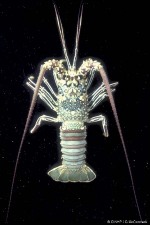Cook Islands Biodiversity Database
Species Page
Panulirus penicillatus
KouraDouble-spine Spiny-Lobster
Multimedia & Additional Resources
General Information
Cook Islands Distribution
| Southern Group: Present Makatea: Present | ||||||||
RR |
MG |
AT |
MK |
MT |
AK |
PL |
TK |
MN |
P |
+++ |
+++ |
^+++ |
^P |
++++ |
|||
| Northern Group: | |||||
TN |
MH |
RK |
PK |
NS |
SW |
P |
|||||
Scientific Taxonomy
Panulirus penicillatus (Olivier, 1791)
SYNONYMS: Astacus penicillatus [O]; Palinurus gigas; Palinurus penicillatus; Palinurus ehrenbergi
TAXONOMY: ANIMALIA; ARTHROPODA; CRUSTACEA; MALACOSTRACA; EUMALACOSTRACA; Eucarida; Decapoda; Reptantia; Palinura; PALINURIDAE
More Information
SIGNIFICANCE NOTES -. Comment: NBSAP - Mitiaro (4= of 10 wild animals)
POSITIVE SIGNIFICANCE: Food. Comments: A popular food.
NEGATIVE SIGNIFICANCE: Poisonous to eat - moderate
GENERAL NOTE: Hides during the day in dark recesses on Outer Reef-slope to 10m during the day. At night move through the surge channels to feed on the reef crest and outer reef-flat, especially when the tide is high on dark nights.
Vouchers & References
Vouchers:
Cooks: JU-104. Mangaia: several specimens, College, 9/2000, ID GMcC. Mauke: field-specimen, College collection, 3/2001, ID GMcC. Aitutaki: field-specimen, NBSAP School, 12/2000, ID GM. Pukapuka: informant report, 2/2004, to G.McCormack.
References:
None recorded.
Data Update History (information):
zTXmx, zB02, zM04b, zD02
Web Resources
Citation Information
McCormack, Gerald (2007) Cook Islands Biodiversity Database, Version 2007.2. Cook Islands Natural Heritage Trust, Rarotonga. Online at http://cookislands.bishopmuseum.org. ![]()
Please refer to our use policy.

